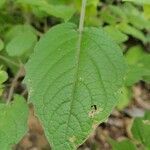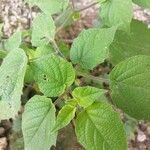Leaves solitary; petiole 0.2–2 cm long, rather sheathing at the base; lamina membranous or papyraceous, 0.8–3.5 × 0.7–3 cm, ovate, sometimes elliptic or deltate, base rounded, ± truncate or sub-cordate, occasionally cuneate, and often ± oblique or unequal-sided, apex obtuse, sub-acute or bluntly sub-acuminate, coarsely sinuate-dentate, the few teeth often unequal, ± triangular, obtuse or sub-acute, the sinuses rounded, lower ones occasionally subentire towards the proximal end, varyingly pubescent-villous and glandular-viscid, with multicellular, spreading or ± appressed hairs, more abundant along the nerves beneath, sometimes subglabrous.
Annual to 50 cm, pubescent with glandular and simple, non-glandular hairs. Leaves alternate; lamina ovate to ovate-elliptic, cordate at base, up to 10 cm (usually c. 6 cm) long, toothed or with obtuse, triangular lobes; petiole to 7 cm long. Pedicels 5–10 mm long. Calyx 6–7 mm long; lobes narrowly triangular, 3–4 mm long. Corolla 5-angled 7–11 mm long, dull yellow with 5 distinct purple-brown spots towards base. Anthers 1.5–2 mm long. Style 4–5 mm long. Fruiting calyx prominently 5-angled, 25–40 mm long, very pale yellow-green, drying to light brown. Berry globular to ovoid, 12–15 mm diam. Seeds disc-shaped, 1.5 mm long, light brown.
Lax annual, with simple and glandular hairs; stems to c. 90 cm tall. Lvs petiolate. Lamina c. 4-12 × 2.5-8 cm, ovate, ± dentate, ± densely covered in appressed hairs; base truncate to cordate, often oblique; apex obtuse. Fls solitary. Calyx hairy; teeth 2-3 mm long, lanceolate, acute. Corolla c. 6-8 mm diam., yellow with dark basal blotch; lobes short, obtuse. Anthers 1.8-2 mm long, yellowish with bluish margin. Fruiting calyx c. 2.5 cm diam., 5-ribbed, densely hairy. Berry 10-15 mm diam., pale yellow; flesh sweet. Seeds 1.5-2 mm diam., almost suborbicular.
Corolla yellowish or dull yellow, blotched with 5 dark purplish-brown markings strongly contrasting with the surrounding limb, 6–7(8) mm long, campanulate; tube glabrous except along the ribs with a few short hairs, on the inside somewhat hairy with long, hyaline hairs especially near the insertion of the stamens and ± matted-hairy below the markings; limb 5–10 mm across, 5-angled to subentire, erect or spreading, on the outside with sparse, short hairs, more dense at the apex and near the margins of the angles, glabrous inside, ciliate.
Erect to procumbent or prostrate, usually slender and diffusely much branched, annual herb, said to reach 2 m, probably much less in the Flora Zambesiaca area, sometimes tinged purple, ± viscid, ± densely clothed with simple, fine, usually multicellular, greyish, whitish or hyaline, spreading, eglandular hairs, sometimes also glandular hairs of varying size, rarely subglabrous, furnished with ± sessile glands too.
An annual herb. It grows 50-120 cm high. It is yellowish-green and has soft hairs. The leaves are simple and thin. The leaves are 2-6 cm long. The flowers occur singly. The flowers are yellow with purple-brown spots. There are several named cultivated varieties. The fruit are round and in a balloon like calyx. The fruit are orange. The pulp is sweet.
Annual to 6 dm, widely branched from near the base, villous or viscid-villous; lvs ovate, 3–10 cm; pedicels 5–10 at anthesis, 5–20 mm in fr; cor 6–10 mm, yellow with a dark center; cal-lobes narrow, 2–4 mm; anthers 1.5–2 mm; fruiting cal 2–4 cm, 5-angled; 2n=24. Moist soil; pantropical, n. to Mass., Ont., and Wis. May–Sept. Three vars. in our range.
Branches subterete-angular, striate, densely pubescent-villous and slightly glandular-viscid, and also with short hairs, sometimes dense, on young parts, in one to several longitudinal lines, occasionally subglabrous on some parts.
Stamens included, unequal, glabrous; filaments 1.5–2.5 mm long, filiform, attached to the corolla tube near the base; anthers bluish to purple, 1.2–1.5 mm long, ovate or elliptic in outline, straight after anthesis.
Fruit yellow or orange when ripe, with a gynobase 0.4–0.5 mm long on the invaginated base of the drooping to pendulous calyx, 7–8 mm in diameter, ± globose, often capitate-glandular.
Flowers solitary, axillary, erect to pendulous; pedicel 3–4(5) mm long, densely pubescent-villous, in fruit elongated to 7(8) mm.
Ovary 1.5 × 1 mm, ellipsoid, glabrous; style 3 mm long, filiform, straight.
Seeds yellowish, 1.8 mm across, ± orbicular in outline, reticulate-foveate.
Disk 0.3–0.4 mm high, fleshy, glabrous.
Flowers yellow with brown centre.
An annual herb about 2 ft. high



